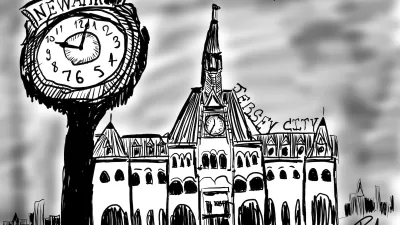With vast technology in this information age we are oversaturated with data. The trouble is planners aren't using this information nearly as much as they could be when it comes to economic development in underserved neighborhoods. The transportation sector collects data on travel patterns, behavioral choices, and modal efficiencies. With GIS technology, we can map socio-economic patterns, predict how rising sea levels will change our coastline,and evaluate development patterns. We even have technology to create more efficient trash collection routes and track real time bus movement for bus travelers. But do planners have a sufficient databank of information to demonstrate demand and purchasing power in underserved neighborhoods? Are we perpetuating disinvestment in these communities by ignoring the data? If data begets knowledge and knowledge equals power, where does that leave us?
We all struggle with ways to attract investors into disinvested communities. In Florida, planners almost always turnto Community Redevelopment Agencies or CRAs, which use tax increment financing to provide gap funding for private developments in unproven markets. And why? Because the traditional data sources, like the U. S. Census and Claritis indicate that households in these disinvested neighborhoods have less purchasing power. And if your development is not a typical residential or commercial product, there simply isn't any industry analysis on its potential demand. These two factors limit investment and the types of investments in poorer neighborhoods. But, critical thinkers are challenging these limitations and finding creative ways to link data to develop a better understanding of how disinvested communities spend their money and how cultural and arts activities encourage investment.
The non-profit company Social Compact has evaluated overlooked economic indicators to demonstrate a neighborhood's economic health. They use real time transactional data to track the daily spending habits of communities and to calculate buying power using non-traditional data sources like tax assessment, building permits, utility usage, bill payments, and consumer expenditure. And their findings are quite extraordinary. They've discovered that in over 400 underserved urban neighborhoods there are nearly 1.25 million additional residents and more than $35 billion in unrecognized income-22% higher than census trend projections. This irrefutable data has given disinvested places the power to attract valuable neighborhood investment without having to provide gap funding. The results are more self-sustaining and self-sufficient neighborhoods.
The Reinvestment Fund (TRF), a Philadelphia based foundation which finances urban real estate, business, and provides data analysis, and Social Impact of the Arts Project (SIAP), a Philadelphia based non-profit policy research group concluded that community based culture and arts can and does encourage private investment, but there is insufficient data to confirm this and no clear method for measurement. SIAP has also revealed that economists are not measuring demand for cultural uses like artist housing, which has a different demand than conventional housing and is more likely to reuse older and underutilized buildings in disinvested neighborhoods. The SIAP study hypothsizes that developments like artist housing engage the community, help create community identity, and signal market renewal. More data research to measure this link between cultural activity and neighborhood development, like Social Compact's research, could empower neighborhoods to attract cultural investment.
Shouldn't planners and economists cultivate this less conventional approach to data collection in disinvested communities by demanding more thorough research and engaging non-profit organizations that are already developing this information? The benefits are astounding. Until then we are doing our communities a great disservice.

Pennsylvania Mall Conversion Bill Passes House
If passed, the bill would promote the adaptive reuse of defunct commercial buildings.

World's Largest Wildlife Overpass In the Works in Los Angeles County
Caltrans will soon close half of the 101 Freeway in order to continue construction of the Wallis Annenberg Wildlife Crossing near Agoura Hills in Los Angeles County.

U.S. Supreme Court: California's Impact Fees May Violate Takings Clause
A California property owner took El Dorado County to state court after paying a traffic impact fee he felt was exorbitant. He lost in trial court, appellate court, and the California Supreme Court denied review. Then the U.S. Supreme Court acted.

New York’s Deadliest Neighborhoods for Pedestrians
Pedestrian deaths rose last year, but remain below pre-2020 levels.

Eviction Looms for Low-Income Tenants as Rent Debt Rises
Nonprofit housing operators across the country face almost $10 billion in rent debt.

Brightline West Breaks Ground
The high-speed rail line will link Las Vegas and the Los Angeles area.
City of Costa Mesa
Licking County
Barrett Planning Group LLC
HUD's Office of Policy Development and Research
Mpact Transit + Community
HUD's Office of Policy Development and Research
Tufts University, Department of Urban and Environmental Policy & Planning
City of Universal City TX
ULI Northwest Arkansas
Write for Planetizen
Urban Design for Planners 1: Software Tools
This six-course series explores essential urban design concepts using open source software and equips planners with the tools they need to participate fully in the urban design process.
Planning for Universal Design
Learn the tools for implementing Universal Design in planning regulations.



























